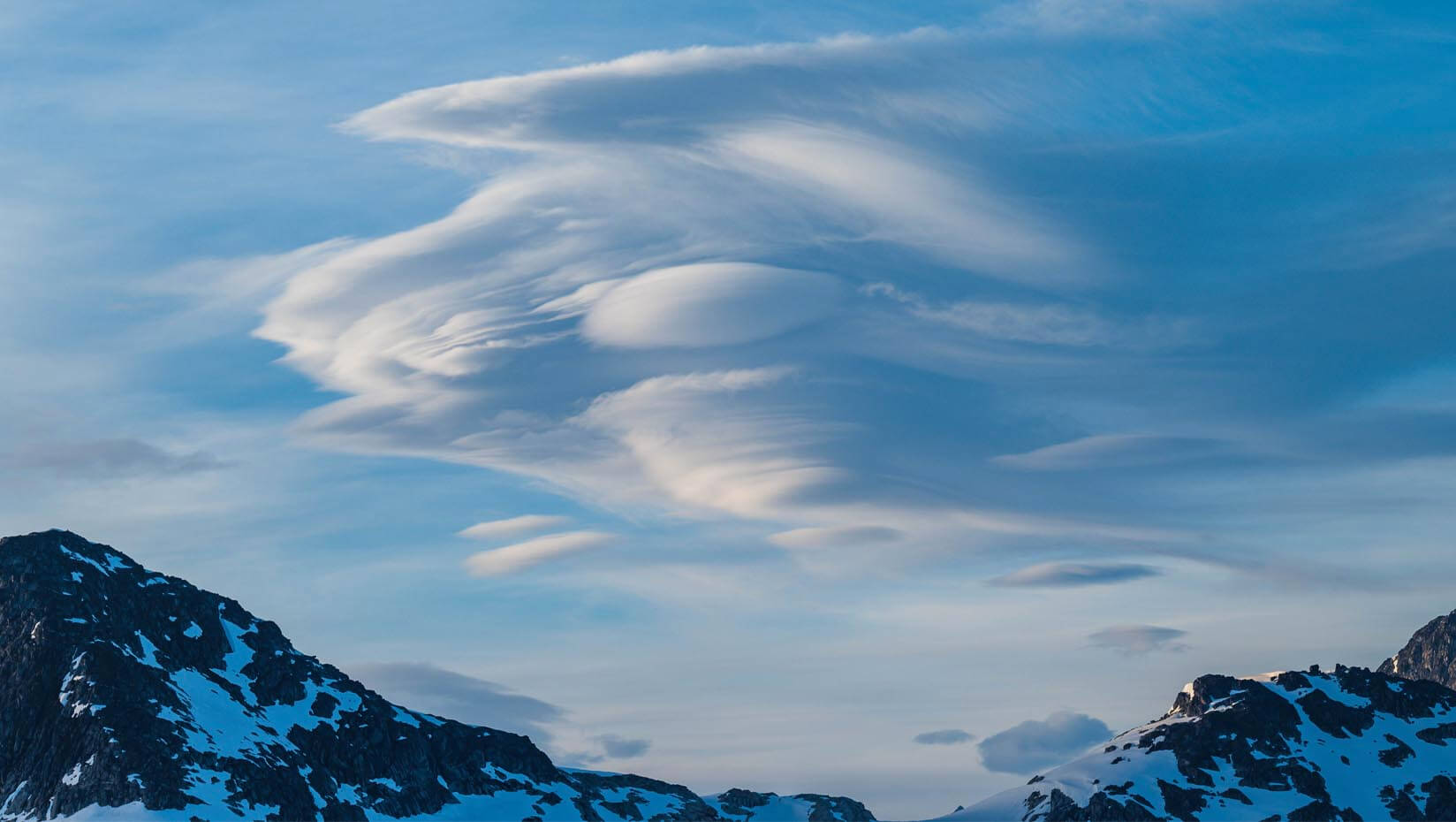4.23.24
Ashley Yates
ashley.depew@maine.edu

A photo showing lenticular clouds over the Juneau ice field in southeast Alaska where the UMaine team intends to conduct research for this partnership project. Photo by Erin Towns
“Climate change is occurring faster in the Arctic than anyplace on Earth,” said University of Maine associate professor of glaciology Seth Campbell. “And with that, there opens a whole range of concerns.”
Campbell is the lead scientist on a new $260,000 research partnership between UMaine and the Department of the Air Force (DAF) to improve the nation’s ability to monitor Arctic regions. Reduction of ice in the Arctic Ocean raises questions about accessibility to the once-frozen waters.
The U.S. is one of eight countries that govern territory in the Arctic. As more resources become available in the region as a whole, Campbell said countries are seeking diplomacy to establish who has rights, including Indigenous communities with sovereignty.
In response to growing interest for the U.S. to have a presence in the Arctic, the DAF is investing in research to understand how to work and operate in the harsh environment, with UMaine’s role focused on weather conditions. The partnership is an effort by the DAF to provide strategic recommendations to Air Force Weather (AFW) for its ongoing digital transformation and to meet its goals outlined in the DAF Climate Action Plan and Arctic Strategy.
“Being involved in a project like this is important because it helps us characterize where we’re at from a science perspective, and potentially where we’re going,” said Campbell.
Partnerships between the university and collaborators across the Arctic like AFW, he said, are critical to the health of the state. For example, Maine has the fastest warming coastal waters on Earth, largely due to climate change in the Arctic, the impact of which has implications for the state’s people, economy and environment.
“Our partnerships assure that Maine has a seat at the table as we work to manage significant environmental changes,” said Campbell.
What he deemed the first leg of the project is a scientific review that he will participate in over the next year with UMaine School of Earth and Climate Sciences Director Karl Kreutz and a university Ph.D. student who has not yet been selected. The team will evaluate current methodologies, research techniques, sensors and sensemaking systems AFW uses to observe and predict weather patterns that affect DAF operations.
A sensor can be any type of equipment that is used to acquire observational data on the atmosphere — from satellites in space to monitors on the ground.
The team will also utilize up to four test sites across Alaska and Northwest Canada to supplement their review — places where Campbell and Kreutz have already conducted research.

Juneau Icefield. Photo by Andrew Opilia
University qualifications
Last fall, AFW team lead Mark Allen approached Campbell with the idea of partnering with UMaine for Arctic research. In addition to his affiliations with the UMaine Climate Change Institute and School of Earth and Climate Sciences, Campbell works with the Juneau Icefield Research Program (JIRP), where students and established scientists gather in Alaska to learn and pool resources to conduct collaborative research. UMaine partnered with JIRP in 2018 when Campbell was hired as their director.
“Very few programs across the country, really globally, place students and faculty into polar field environments as much as UMaine,” said Campbell. “I think that’s a strength that we bring to this specific project, because we collaborate in so many field programs established between Alaska and Canada and Greenland, for example, and elsewhere.”
Four of Campbell’s current graduate students participated in JIRP as undergraduates and are working on their graduate research at UMaine. Campbell said they’ve had significant field experiences through the opportunities the university offers.
“In a scientific context, field research is critical in that it allows us to make direct observations of dynamic environments as they’re changing,” said Tahi Wiggins, a current UMaine graduate research assistant who participated in JIRP as an undergraduate. “More broadly, though, being in these immense environments induces a sense of humility: you’re concerned with the science objective but also with your bodily safety, with the sound of crashing ice, with the color of the sky each day. It’s a profound and wonderful part of our education.”
JIRP operates in Alaska and Canada through a nonprofit called the Foundation for Glacier and Environmental Research, and it is the longest-running polar field training program in North America. Over the past decade, UMaine has conducted research at several other extreme cold-weather places that Campbell said has produced data that will also help inform his team’s review.
The research partnership between UMaine and the AFW is funded for one year, but the intention is to continue it each year and further integrate UMaine students. Campbell said his hope is that over time, university-associated field study sites could serve as a base for testing new weather sensing technology for AFW.
In addition to the research partnership, the DAF and UMaine are coordinating to reestablish educational agreements for AFW and environmental sciences officers to pursue graduate degrees at the university.
See the full article here.
Comments are invited and will be appreciated, especially if the reader finds any errors which I can correct.
five-ways-keep-your-child-safe-school-shootings
Please help promote STEM in your local schools.
The University of Maine is a public land-grant research university in Orono, Maine. It was established in 1865 as the land-grant college of Maine and is the flagship university of the University of Maine System. The University of Maine is one of only a few land, sea and space grant institutions in the nation. It is classified among “R2: Doctoral Universities – High research activity”.
With an enrollment of approximately 11,500 students, The University of Maine is the state’s largest college or university. The University of Maine’s athletic teams, nicknamed the Black Bears, are Maine’s only Division I athletics program. Maine’s men’s ice hockey team has won two national championships.
The University of Maine was founded in 1862 as a function of the Morrill Act, signed by President Abraham Lincoln. Established in 1865 as the Maine State College of Agriculture and the Mechanic Arts, the college opened on September 21, 1868 and changed its name to the University of Maine in 1897.
By 1871, curricula had been organized in Agriculture, Engineering, and electives. The Maine Agricultural and Forest Experiment Station was founded as a division of the university in 1887. Gradually the university developed the Colleges of Life Sciences and Agriculture (later to include the School of Forest Resources and the School of Human Development), Engineering and Science, and Arts and Sciences. In 1912 the Maine Cooperative Extension, which offers field educational programs for both adults and youths, was initiated. The School of Education was established in 1930 and received college status in 1958. The School of Business Administration was formed in 1958 and was granted college status in 1965. Women have been admitted into all curricula since 1872. The first master’s degree was conferred in 1881; the first doctor’s degree in 1960. Since 1923 there has been a separate graduate school.
Near the end of the 19th century, the university expanded its curriculum to place greater emphasis on liberal arts. As a result of this shift, faculty hired during the early 20th century included Caroline Colvin, chair of the history department and the nation’s first woman to head a major university department.
In 1906, The Senior Skull Honor Society was founded to “publicly recognize, formally reward, and continually promote outstanding leadership and scholarship, and exemplary citizenship within the University of Maine community.”
On April 16, 1925, 80 women met in Balentine Hall — faculty, alumnae, and undergraduate representatives — to plan a pledging of members to an inaugural honorary organization. This organization was called “The All Maine Women” because only those women closely connected with the University of Maine were elected as members. On April 22, 1925, the new members were inducted into the honor society.
When the University of Maine System was incorporated, in 1968, the school was renamed by the legislature over the objections of the faculty to the University of Maine at Orono. This was changed back to the University of Maine in 1986.


